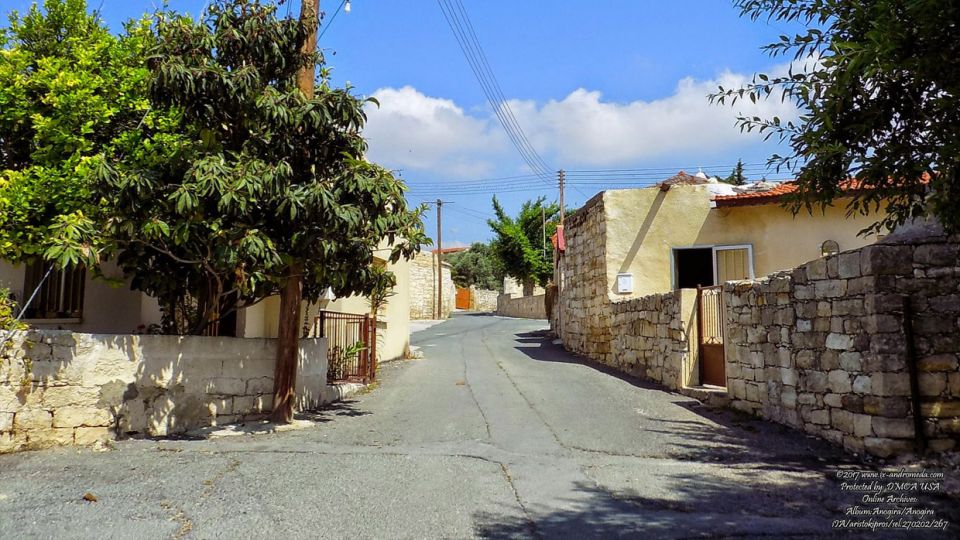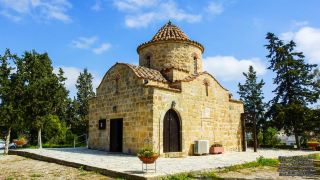Anogira is a village of the Limassol district and it is at a distance of 42 kilometres from the city. It is found northwest of the town, built on a huge plateau which extends for many kilometres. It is a village built of limestone. Its 300 settlers mainly deal with agriculture and carob processing, thus producing the ancient, traditional sweet that is called “ Pasteli”.
To travel to Anogira you will have to pass through a very wild and violently transformed place. From the first moment you will leave the village of Avdimou behind you, once you go uphill towards the hill on whose peak Anogira is found, you will notice the deep ravines that the rainwater carved through the years.
The hills are “sown” with huge rocks that cause awe with their “fragile” equilibrium. The road is uphill, narrow and helical and it takes you up many metres at each turn, thus giving you the opportunity to see the landscape 10 kilometres away, where the sea is found.
Halfway through, there is an ancient faucet that will give you water and a cave, dug by time into the limestone which will challenge you to explore it, a few metres further.
Upon reaching the outskirts of the village, on your right you will face the ruins of three Christian Churches, that were part of the abandoned Monastery dedicated to Timios Stavros (Holy Cross).
When entering the village, you can only be surprised by the amount of stone that was needed to build a village. Everything is made up of stone. Houses, buildings, monuments.
The houses’ architecture takes us effortlessly to the years when Cyprus was often raided by its Arab neighbours. There are high surrounding walls with only one entrance that end up in an internal yard, around which necessary rooms are found. Each house is joined to another, thus obstructing any entrance to the raiders.
In the centre of the village there is a parish church. It is a very beautiful and old construction (out of stone). Next to an oil press, where you can see the millstone with which they used to grind olives, as well as the “clamp” through which olive oil was extracted. Further on, you will find the monument in the honour of the Hero of Cyprus who gave his life fighting for his country against the Turkish raider.
You will need many hours and you will walk a lot to see and get to know the neighbourhoods of the village. Each house attracts your attention. Each door will have a story to tell you. Nevertheless, take care. The streets are narrow, but they are not alleys. They are covered in asphalt and they are accessible to vehicles. There are no signs and this makes them dangerous for pedestrians. The square in which the offices of the community council are found is paved, something that should be done in other streets too. This would help the visitors feel safer when walking along the village.
In order to be able to understand the village’s character, we will have to go a long way back into time. We will go to 1600 B.C., and to Late Bronze Age. Back to when the Kings of the Greeks, when leaving from Troy found shelter in Cyprus. They brought along their Gods, their arts and their recipes for tasty sweets and food. One of these recipes was “Pasteli”. A very tasty sweet, whose relish and sweetness made Homer write it down in the Iliad.
Later on this sweet started being produced in Anogira, but this time it was not made of honey from the bees, but from honey that they exported, from the fruit of the carob tree. In a very short period of time, the reputation of this sweet was known all around the world. Many traders ascended the inaccessible and rugged road to Anogira.
The plantations of the carob trees multiplied year by year. Thousands of trees were planted to satisfy the urge of the traders for income. The multiple use of the carobs made it one of the most precious products. Even their pips were bought for different uses.
Carob trading carried on until the middle of the past century. With the island’s independence and the rudimentary freedom that the Cypriots had, old occupations passed into the “time closet”. The produce of carobs became unprofitable and was abandoned. The last plantation that was created, is found deserted in the area between Kokkinotrimithia and Mammari in the district of Nicosia.
Thousands of trees were felled and turned into firewood for fireplaces of nouveau riche Cypriots although the felling of carob tree is prohibited.
In Anogira you will have the opportunity to see how this sweet is produced.




